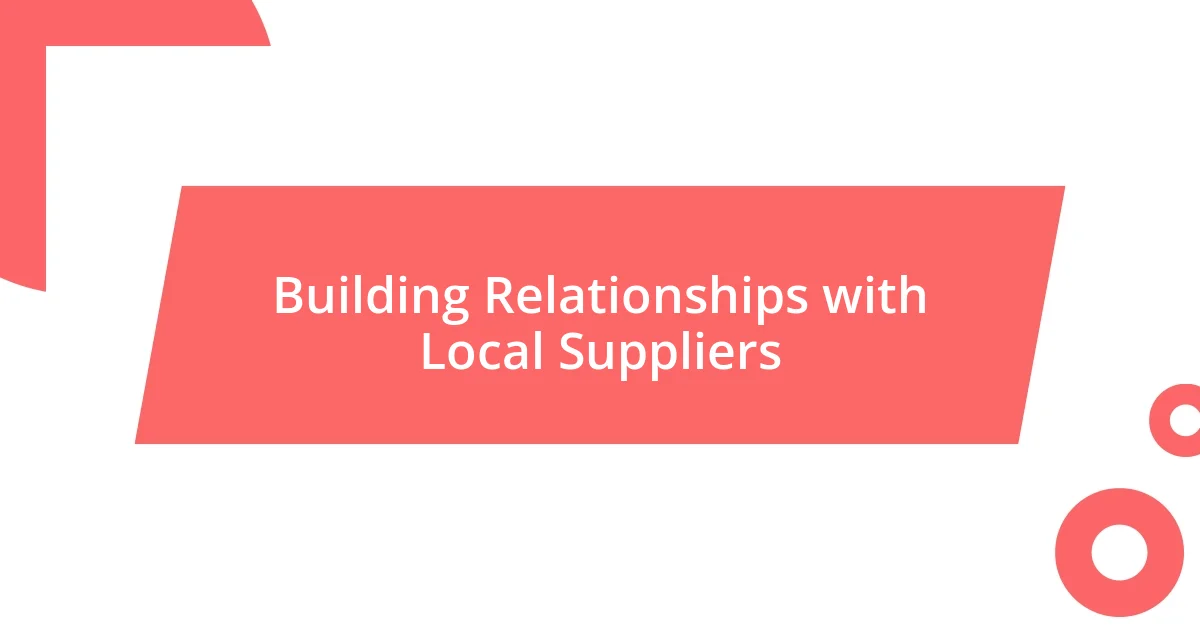Key takeaways:
- Local beverages reflect community identity and foster connections through shared stories and cultural practices.
- Effective exploration of local producers includes engaging with them via markets, social media, and tasting events to strengthen appreciation and relationships.
- Curating a balanced beverage selection requires considering seasonal changes, diverse options for dietary needs, and effective marketing strategies to enhance community experiences.

Understanding Local Beverage Culture
Local beverage culture is a fascinating reflection of community identity and shared history. I remember my first visit to a small vineyard in my hometown; the owner proudly shared stories about how each wine represented the region’s unique terroir. Have you ever tasted a drink that instantly transported you to another place or time? That’s the magic of local beverages—they encapsulate the essence of their surroundings.
In exploring local drinks, I’ve found that they often serve as a catalyst for connection. During a local beer festival, I struck up a conversation with a brewer who spoke passionately about his family’s recipes, passed down through generations. It made me realize that local beverages can spark stories and foster a sense of belonging. Isn’t it inspiring how a simple drink can bring people together?
Understanding the nuances of local beverage culture means appreciating not just the flavors but also the traditions and rituals surrounding them. I recall attending a tea ceremony that focused on mindfulness and respect in the act of brewing and serving. It transformed my perception of a routine drink into a beautiful ritual. How does beverage culture in your community reflect the values and stories of its people?

Identifying Local Producers and Brands
Identifying local producers and brands often begins with a simple exploration of your surroundings. I remember wandering through my neighborhood market, where I stumbled upon a small stand featuring artisanal sodas made from fruits grown just a few miles away. It struck me how these producers not only create unique flavors but also contribute to the local economy. How often do we stop to consider the stories behind the products we consume?
When diving deeper into the discovery process, using social media can be incredibly useful. I’ve often checked Instagram to find local breweries showcasing their latest creations or distilleries sharing insights into their production process. It feels like entering a community of enthusiasts and makers who are eager to share their passion. Have you ever found yourself scrolling through an account that made you want to visit a place just for a taste?
A solid strategy is joining local tasting events, which can introduce you directly to producers. At one memorable event, I met a passionate cider maker who shared her love for farm-fresh apples and the art of fermentation. It was an engaging experience that opened my eyes to the importance of sourcing ingredients sustainably. Have you ever left a tasting with not just a new favorite drink but also a closer connection to its creator?
| Method | Personal Experience |
|---|---|
| Neighborhood Market | Discovered local artisanal sodas made from nearby fruits. |
| Social Media | Followed local breweries on Instagram, leading to a deeper appreciation for their craft. |
| Tasting Events | Connected with a cider maker and learned about sustainable sourcing firsthand. |

Researching Consumer Preferences
Researching consumer preferences is a journey into understanding the tastes and desires of the local community. I often find myself buried in surveys and focus groups, collecting insights that reveal what people genuinely enjoy. Recently, at a local farmer’s market, I passed out quick questionnaires asking visitors about their favorite beverages. The responses flooded in, bringing unexpected details—like a surprising love for elderflower-infused drinks, which I hadn’t considered before.
To engage effectively with consumers, I think it’s vital to consider several avenues for gathering data:
- Surveys and Questionnaires: Directly ask the community about their preferences and experiences.
- Social Media Polls: Leverage platforms like Instagram or Facebook to create quick polls on favorite drinks.
- Local Events Feedback: Engage participants at tastings or festivals to share their thoughts on what they enjoyed.
- Informal Conversations: Sometimes, casual chats over a drink reveal insights that structured methods miss.
These methods not only provide invaluable information but also foster a connection with the community, helping me curate choices that truly resonate with their tastes.

Tasting and Evaluating Beverages
When it comes to tasting and evaluating beverages, I think the experience goes beyond just sipping; it’s about embracing the entire sensory adventure. I recall attending a local tasting event where I closed my eyes and focused solely on identifying the unique aromas wafting from a glass of craft beer. Can you imagine how much richer this experience becomes when we savor the hints of citrus or toast, allowing our senses to guide us?
During my tasting adventures, I’ve often found that jotting down notes enhances my ability to evaluate flavors accurately. For instance, after trying a vibrant red wine from a nearby vineyard, I found myself scribbling phrases like “cherry notes with a touch of oak” and “smooth finish” in my notebook. This practice not only sharpens my palate but also creates a personal reference that I can revisit later. Have you ever captured a moment like that, only to discover later how those expressions helped you recount the entire tasting experience?
In my opinion, tasting is as much about personal discovery as it is about the beverage itself. I’ll never forget the first time I tasted a locally-made kombucha; the effervescence danced on my tongue while I marveled at the complexity of flavors. Each sip felt like a delightful surprise, leading me to ponder how the fermentation process influenced its character. Isn’t it fascinating how a seemingly simple drink can evoke so many thoughts and emotions? Engaging with beverages this way not only deepens appreciation but fosters a connection that transcends the drink itself.

Creating a Balanced Beverage Selection
Creating a balanced beverage selection is all about diversity and harmony. I often think about the different types of flavors and experiences I want to offer, from refreshing botanicals to robust reds. For instance, at a recent event, I decided to include not just your standard fruit juices, but also unique options like rosemary lemonade, which really surprised people. It was that perfect mix of familiar and adventurous.
I also believe the seasonal aspect is crucial in curating beverages. Local selections shine when they reflect the time of year. Last summer, I focused on light, crispy wines and fruity spritzers that echoed the sunny days. But as autumn rolled in, I transitioned to warm spiced ciders and rich stouts—what a delightful shift! Have you ever noticed how the ambiance of a season affects your drink choice?
Nurturing a balance also means catering to various dietary needs and preferences. I tried to include gluten-free options and vegan-friendly drinks, which broadened my audience significantly. One memorable experience was offering a delicious coconut water-based mocktail alongside a vibrant red cocktail. This way, everyone felt included, and it made the whole gathering feel more inviting. After all, beverage curation is about making connections, isn’t it?

Marketing and Promoting Local Choices
When it comes to marketing and promoting local beverage choices, I’ve found that storytelling is a powerful tool. During one neighborhood fair, I collaborated with a local distillery to feature their artisanal spirits. We created a compelling narrative around their family-owned history and the unique ingredients sourced from nearby farms. Isn’t it amazing how a simple story can turn a beverage into a memorable experience?
Utilizing social media has also been a game changer in reaching broader audiences. I remember posting a beautifully crafted cocktail from a local bar, tagging them in the process. The likes and shares exploded! People love to see the face behind the drink, and those vivid images not only showcased the beverage but also built a community appetite for locally sourced options. Have you ever felt the buzz of excitement when a post resonates with others?
Another effective strategy I’ve experienced is hosting pop-up events that focus solely on local choices. I vividly recall organizing a wine and cheese pairing night with local vendors, and the energy was palpable. Guests were thrilled to connect with producers, and many discovered their new favorite beverage right then and there. It brought to life the idea that local choices aren’t just drinks; they’re a celebration of our community. How do you think that sense of belonging influences our beverage selections?

Building Relationships with Local Suppliers
Building strong relationships with local suppliers is not just about transactions; it’s about fostering a sense of community. I remember when I first began sourcing from a small vineyard nearby. I took the time to visit their estate, share a glass, and understand their farming practices. This personal touch not only deepened my appreciation for their craft but also laid the groundwork for a partnership built on mutual respect and trust.
During one particularly memorable harvest season, I called on local brewers to create a unique collaboration brew tailored for an event I was coordinating. The excitement was infectious—working alongside them not only enhanced my knowledge of fermentation processes but also gave the brewers an opportunity to showcase their creations to a broader audience. Have you ever felt that thrill when you’re part of something bigger than yourself? That’s what these relationships can create.
Beyond the business aspect, maintaining open lines of communication with suppliers is vital. I regularly touch base, not just for orders but to exchange ideas about what’s trending in the beverage world. This dialogue often leads to innovative pairings or exclusive offerings that we can present to our clients. When I check in and they share their latest experiment with a new flavor, I can’t help but think: how indispensable are these connections in keeping our selections fresh and exciting?















